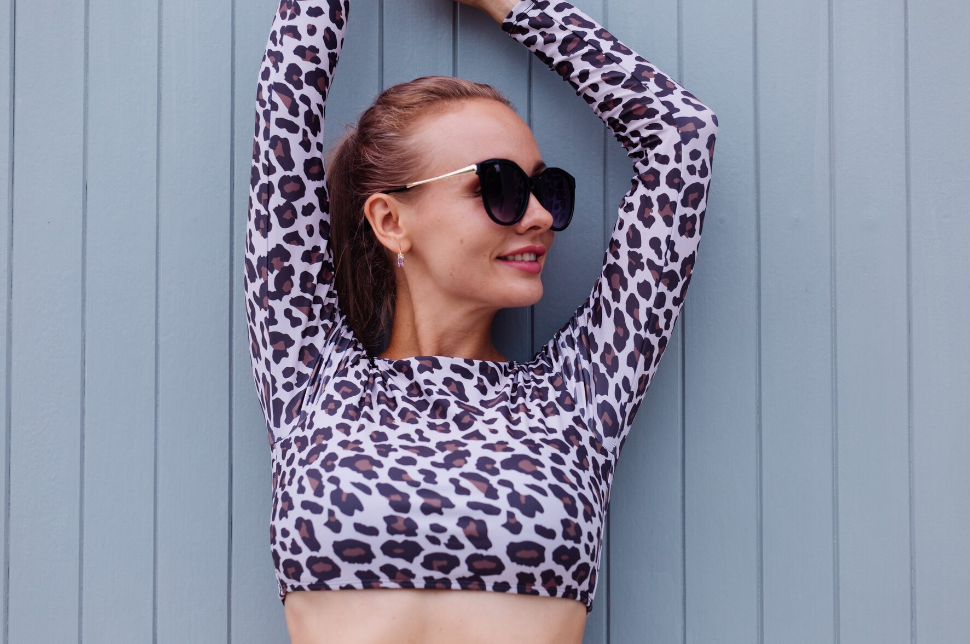Introduction:
Leopard print has long been a symbol of fierce and timeless style in the fashion world. Women’s leopard print tops continue to capture the hearts of fashion enthusiasts. In this blog, we will explore the latest trends in women’s leopard print tops, highlight celebrity endorsements and fashion events that have showcased these products, and delve into effective styling and sales strategies. Additionally, we will discuss the choice of materials and manufacturing processes and how to find reliable suppliers.
Part 1: The Latest Trends in Women’s Leopard Print Tops
1.1. Runway Influence
Leopard print tops have graced fashion runways in recent seasons. We will discuss:
- Design Innovations: Explore how designers have reinvented the classic leopard print top with creative designs, cuts, and embellishments.
- Color Palette: Highlight variations in color schemes, from traditional leopard hues to bold and unconventional choices.
1.2. Celebrity Endorsements
Celebrities often influence fashion trends. We’ll take a closer look at celebrities who have embraced leopard print tops:
- Red Carpet Appearances: Share examples of famous personalities wearing leopard print tops on the red carpet and how it influences the fashion world.
- Street Style: Discuss how celebrities incorporate leopard print tops into their everyday wardrobes and how this shapes consumer choices.
1.3. Sustainability in Fashion
Sustainability is an ever-growing concern in the fashion industry. We’ll explore how the production of leopard print tops is aligning with sustainability:
- Eco-Friendly Fabrics: Highlight the use of sustainable materials in leopard print top production, such as recycled or organic fabrics.
- Ethical Practices: Discuss the importance of ethical manufacturing processes, including fair labor practices and transparent supply chains.

Part 2: Styling and Sales Strategies
2.1. Seasonal Versatility
Leopard print tops can be styled for various seasons. We’ll discuss:
- Summer Looks: Suggest how to pair lightweight leopard print tops with skirts, shorts, and accessories for a summery feel.
- Fall and Winter Wardrobe: Provide tips on layering leopard print tops with coats, scarves, and boots for colder seasons.
2.2. Targeted Marketing
To maximize sales, a targeted marketing strategy is crucial. We’ll delve into:
- Identifying Your Audience: Explain how to identify your target audience for leopard print tops and tailor your marketing efforts to reach them effectively.
- Leveraging Social Media: Discuss the power of social media platforms for showcasing leopard print tops and offer tips for creating engaging content.
2.3. Product Customization
Customization can set your business apart. We’ll explore:
- Materials and Workmanship: Explain how the choice of materials and craftsmanship impacts the quality and appeal of leopard print tops.
- On-Demand Personalization: Discuss the option of offering on-demand personalization, allowing customers to add their unique touch to their purchases.

Part 3: Sourcing and Supply Chain
3.1. Choosing Suppliers
Selecting the right suppliers is a critical factor in the success of your business. Here, we’ll provide an in-depth guide on sourcing and selecting suppliers for women’s leopard print tops:
- Supplier Vetting: Explain the importance of thorough research and vetting when it comes to selecting suppliers. Discuss the criteria you should consider, such as reputation, quality standards, compliance with ethical manufacturing practices, and reliability. Provide a step-by-step process for vetting potential suppliers.
- Communication and Negotiation: Offer insights into effective communication with suppliers, including language barriers, time zones, and cultural differences. Discuss negotiation tactics for securing favorable terms and prices.
- Quality Control: Highlight the significance of setting up a robust quality control process, including inspections, testing, and feedback mechanisms. Describe how to maintain consistent quality standards and address any issues promptly.
- Transparency and Ethical Practices: Emphasize the importance of working with suppliers who adhere to ethical practices, including fair labor conditions and transparent supply chains. Discuss how you can verify and promote ethical manufacturing processes.
3.2. Material Selection
Materials are a crucial component of leopard print tops. We’ll provide comprehensive information on material selection:
- Fabric Options: Explore the various fabric choices available for leopard print tops. Describe the characteristics, advantages, and limitations of each material. Include examples such as silk, chiffon, and sustainable fabrics like organic cotton or Tencel.
- Quality Assurance: Explain how to ensure the quality of the chosen materials, including factors like colorfastness, durability, and texture. Share best practices for conducting material quality tests or assessments.
- Sustainability and Eco-Friendly Materials: Discuss the growing demand for sustainable fashion and how you can align with this trend. Highlight the benefits of using eco-friendly materials and how to source them from environmentally responsible suppliers.
- Local vs. International Sourcing: Compare the advantages and disadvantages of sourcing materials locally versus internationally. Discuss considerations such as cost, lead times, and quality control when making this decision.
Q1: How can I ensure that my leopard print tops are sustainably sourced and produced?
A1: To ensure sustainability, you can partner with suppliers who follow eco-friendly practices, use certified sustainable materials, and have transparent supply chains. Additionally, consider obtaining certifications like Global Organic Textile Standard (GOTS) or Fair Trade to showcase your commitment to sustainability.
Q2: Are there specific fashion events where I can discover the latest trends in women’s leopard print tops?
A2: Yes, major fashion events like Fashion Weeks in New York, Paris, Milan, and London often feature designers who showcase the latest trends, including leopard print tops. Attend these events or closely follow their coverage to stay updated on emerging trends.
Q3: How can I effectively market leopard print tops to different age groups and style preferences?
A3: Segment your marketing efforts to cater to diverse age groups and style preferences. Tailor your messaging and visuals to each segment. For instance, highlight versatility for younger audiences and sophistication for more mature customers. Utilize social media platforms with targeted advertising to reach specific demographics.
Q4: What is the importance of storytelling and branding in marketing leopard print tops?
A4: Storytelling and branding help create a connection with your customers. By sharing the story behind your leopard print tops, such as the inspiration, craftsmanship, or ethical practices, you can build brand loyalty and differentiate your products in a competitive market.
Q5: How can I handle returns and exchanges effectively to ensure customer satisfaction?
A5: Develop a clear and customer-friendly return and exchange policy. Make the process hassle-free for customers, and clearly communicate the steps involved. Promptly address any issues or concerns, and offer options for refunds or replacements, as this will enhance trust and customer satisfaction.
Q6: Can you provide insights into using data analytics for inventory management and predicting consumer preferences for leopard print tops?
A6: Data analytics can be valuable for inventory management. By analyzing historical sales data, customer reviews, and trends, you can make data-driven decisions about stocking levels and product offerings. This can help reduce overstock and improve inventory turnover.
Conclusion:
Women’s leopard print tops have maintained their allure and relevance in the ever-evolving world of fashion. By staying updated on the latest trends, adopting sustainable practices, and implementing effective styling and marketing strategies, fashion retailers can capitalize on the enduring popularity of leopard print. Additionally, making informed decisions regarding materials, manufacturing processes, and supplier choices will contribute to the success and sustainability of businesses in the fashion industry.







